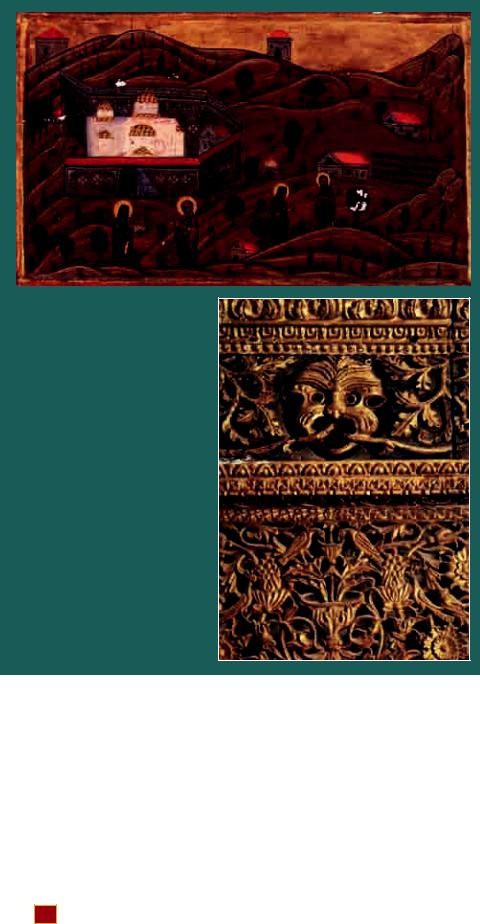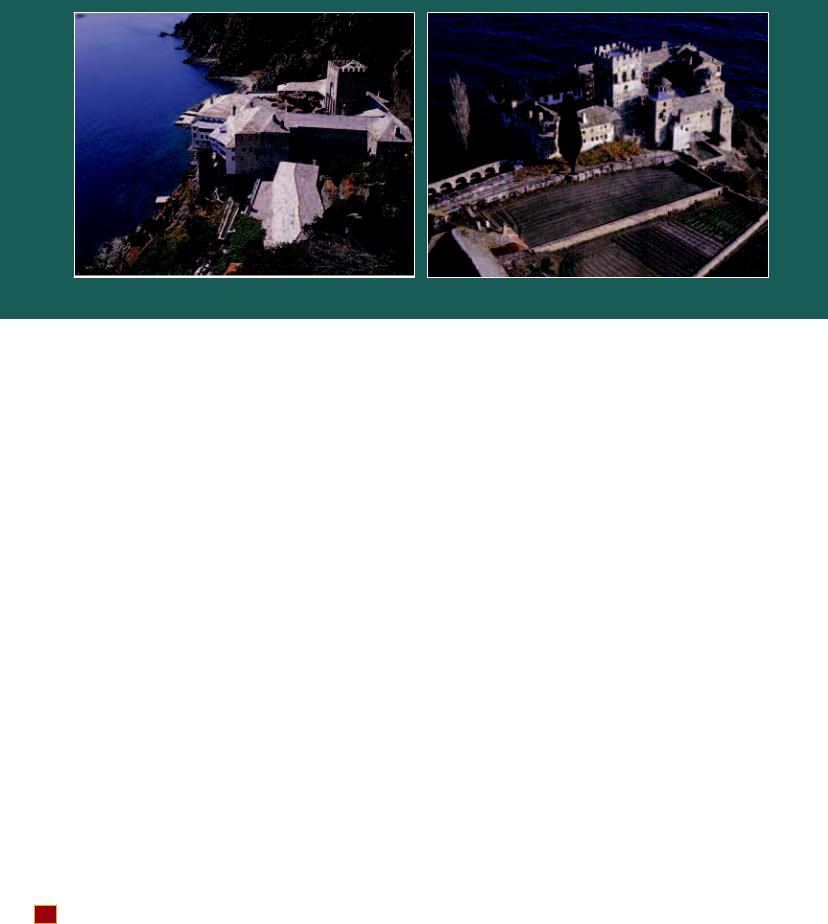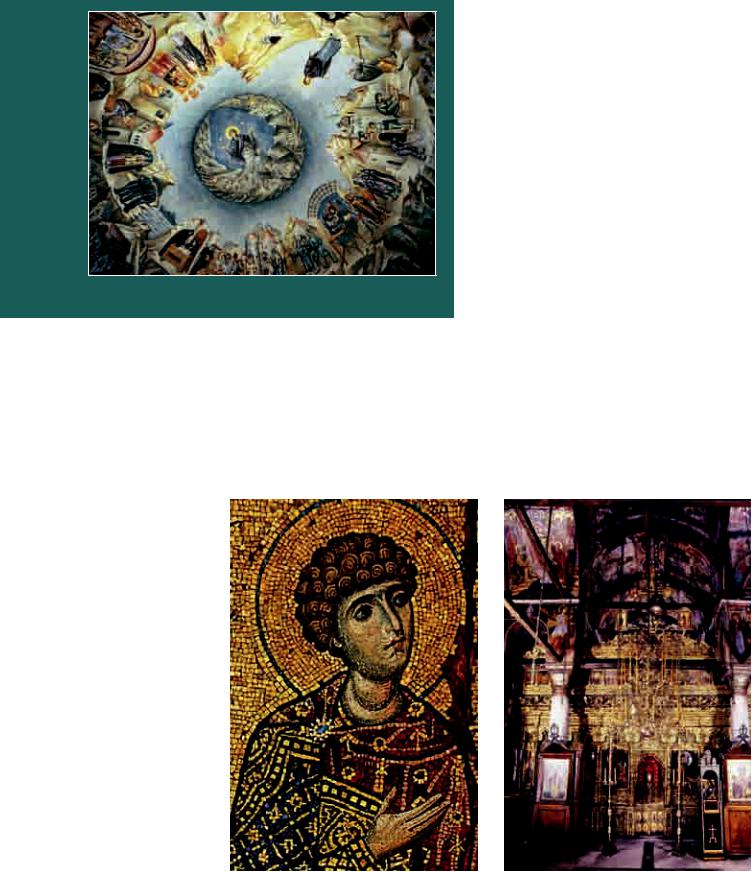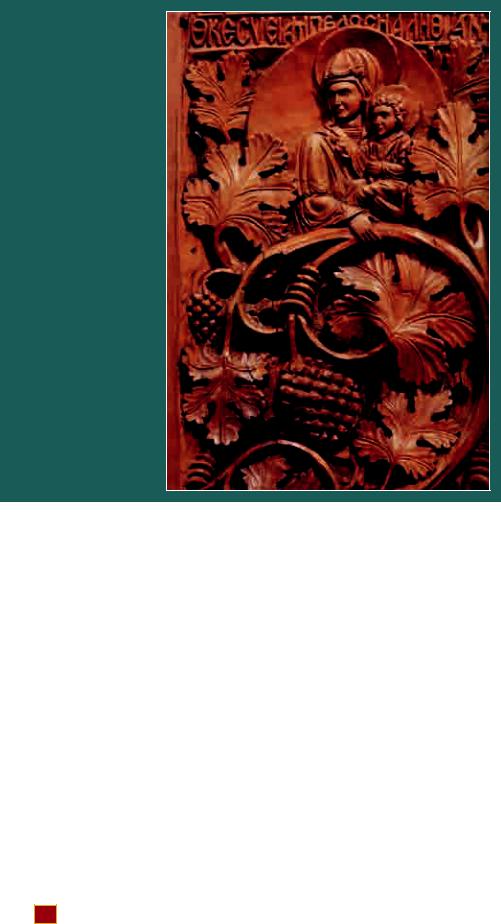
ICCROM_ICS03_ReligiousHeritage_en
.pdf
certainly did not expect whites to do it on their behalf. Members of the cultural group, Matabele Home Society, used to visit the grave, particularly in the 1940s. the royal praises of king Mzilikazi were recited.
As with the Njelele shrine, hope was high that the grave would receive more respect after independence. the khumalos – king Mzilikazi belonged to this clan – had their own ideas about respect, ideas that the Museum staff respected and followed.
However, independence did not restore the expected glory and power to the shrine. the same modernizing influences were at work. If anything, these forces were given more vigour as more churches opened up in the Matopo Hills area.11 the peace and tranquillity that followed the end of the hostilities in 1979 and the dissident era (1983-1987) saw tourism boom. the old ideology of the shrine was not restored. the environment became the victim of the conflict between economically driven human activities and the conservation conscious ideology of the living religious heritage.
the independence period
zimbabwe attained its independence in 1980. the guerilla war that had reached the Matopo hills came to an end. Internal strife lasted from about 1982 to 1987, when the Unity Accord between zANU Pf and Pf zAPU was signed.
With peace prevailing and zimbabwe re-admitted into the world of nations, its status as a pariah state ended. tourism boomed. Human economic activities in the area were accentuated. More schools, both secondary and primary, were opened up. the health delivery services were expanded with the establishment of rural health centres. these social services, coupled with the introduction of more churches, brought new knowledge and value systems and their adoption by the community.
economic activities, now totally freed from religious dictates and directions, combined with an increasing population of ‘freed Africans’ to undermine the influence of the shrines. A dual onslaught ensued: the raison d’être of the shrines themselves was being questioned, and a decline in their influence meant, in practical terms, disregard for the conservation of the environment.
the delicately balanced ecosystem came under threat, particularly in the communal areas where there was greater pressure on the land. the establishment of the Matopos National Park now holds out the hope of conserving the environment.
government policy has not helped the situation either. the religious shrines have not been declared
national monuments. the National Museums and Monuments Department plays only a supportive role. In the name of respecting traditional religious values, the staff of the department left custodianship to the local leadership, which included the chiefs. Without any legal mandate for the shrines, NMMD staff have their hands tied. the perceived political power of the shrines has not helped the situation either. the political leadership has interfered in the choice of shrine custodians: the perceived political influence of the shrines is seen as an opportunity for unlocking the door to economic power.
Chiefs and government officials from Matabeleland South will convene an urgent meeting in the provincial capital gwanda this week to seek ways of resolving the dispute at the Njelele rain-making shrine.
(the ChroniCle, 22 DeceMBer 1999)
the Matopo Hills areas should be viewed as an oasis in an area that is otherwise arid. On the basis of its geomorphological uniqueness, a natural habitat with a wide variety of flora and fauna, and a cultural landscape found nowhere else in zimbabwe, there is a need to conserve this legacy for the benefit of current and future generations. this will happen if all concerned inculcate the ideology of environmental conservation. the rock art holds out the promise of providing a clearer understanding of the human history of the area. the art goes beyond the history of mankind to embrace the natural landscape, especially the flora and fauna present in the Matopo Hills area in centuries gone by.
the absence of an empowered conservation ideology will affect both the natural and cultural landscapes. for centuries the locals espoused that ideology. With colonization, their ideology has been tampered with. While this has been happening, the new Western ideas on conservation have not yet been embraced. this transitional period, lacking any ideology, poses a real threat to the unique environment of the Matopo Hills. for example, the demand for curios has led to a serious depletion of the grey mukwa tree (Pterocarpus angolensis). the taboos that related to the cutting down of trees have not been respected. they no longer hold sway over the population, whose immediate concern is maximizing profits. Depletion of the forests alters the microclimates of the area, making it more susceptible to general erosion and degradation.
the attraction of the Matopo Hills area is based on inter alia the pristine condition of its forests. As the trees are harvested and the grass cut down to thatch rural houses, the economic base of the
64 conservaTion of living religious heriTage

FIguRe 5 the panoramic
view from inside the cave
area will shrink. A Matopo Hills area devoid of the vegetation will attract fewer tourists, and yet it is the tourists who provide the market for curios carved from the forests.
Where tourists and locals are not guided by a conservation ideology, the rock art with all its history and spiritual significance will be threatened. Vandalism is already on the increase and graffiti proliferating. Once again, the Matopo Hills area without its rock art is a mere conglomeration of rocks.
the stark contrast between the nearby rural areas and the Matopo National Park bears proof of how easily the environment can be altered. trees have been cut down to fence the fields and for construction work. trees are also cut down for firewood. With the veld exposed, soil erosion has taken its toll. the ecosystem is disturbed. Dams are silted. the aesthetic and economic value of the area is reduced, to the detriment of both the local inhabitants and the intending tourists.
While the Matopo National Park pushes for the conservation of the environment, the rural folk in adjoining communal lands see things differently. Stripped of their religious ideology, they are infused with a new economically-driven and conservationunconscious ideology. they want to cut down trees for various economic purposes. the rock dassie (or Hyrax) and other animals are hunted with impunity. the perpetrators feel no sense of guilt at all, and meanwhile the government is not using its power to promulgate and enforce conservation laws. In any case, the best approach for conservation should flow from an inner conviction rather than from fear of breaking the law. the latter is not sustain-
able. In the absence of alternatives, the rural folk will continue to exploit the resources of the Matopo Hills area.
As |
more and more |
||
pressure |
is |
exerted |
|
on |
the |
environment, |
|
breaking |
point |
will be |
|
reached. |
|
|
|
|
It is hoped that the |
||
declaration of the area as a World Heritage Site will throw a positive spotlight on the area, especially with regard to conservation of the living religious heritage and the wider natural environment. After all, it is
the natural and cultural landscapes that make the Matopo Hills unique.
With regard to the living religious heritage, it is vital that its management is well thought out. Archaeology deals with three-dimensional objects and not spiritual matters. the management of this aspect of the Matopo Hills area is best undertaken by these with knowledge and insights into religious matters. those without this background will be confounded by the seeming intricacies of the spiritual world and leave everything to the local leadership who, with their limited academic grounding, will yield to the dictates of technical experts, be they ornithologists, botanists, zoologists, environmentalists or, indeed, archaeologists. Respecting living religious heritage is not the same as abandonment, born of little knowledge. Archaeology will have to yield to ethnography if meaningful and sustainable progress is to be made.
the same issues emerge with regard to the grave of king Mzilikazi. failure to understand Ndebele religious philosophy has led to a lack of guidance on the matter. that failure is passed off as respect for traditional religious values:
We [the museum’s staff] gave the khumalo clan the mandate to choose the stones that are to be used as well as the supervision of the whole project, everything is being done according to their requests as the custodians of the grave.
(The chronicle, 25 May 2003)
5 • A living religious shrine under siege |
65 |
|
|

Conclusion
this paper has attempted to highlight the uniqueness of the Matopo Hills area, a uniqueness that reflects the particular value of its cultural and natural landscapes. Over the years conservation ideology espoused by the rain-shrines has preserved the environment and ensured the survival of the ecosystems.
When indigenous knowledge and ideology systems began to diminish in the face of Western and scientific ideas, this unique environment became the victim. Human economic activities impacted negatively on the environment. traditional religious ideology has been in conflict with the forces of modernization.
It is clear that when traditional religious values are no longer in tandem with the broader current values, the former becomes the victim. When those traditional religious values which hold out hope for the conservation of the environment are not respected, ultimately it is the environment that suffers. An ideology of conservation is necessary if the environment is to be conserved. the values need not necessarily be religious in origin. What is critical is the existence of a set of values that guide human activity in the exploitation of environmental resources.
A management structure and culture should be in place to guide the conservation of the living religious heritage. the structures should be buttressed by legislation which is cognizant of all the necessary dynamics. the said structures must be manned by people with relevant qualifications. A full understanding of man and his motives requires a multidisciplinary approach in which ethnographers and historians play development roles.
If maximum benefits are to flow from the Matopo Hills area, now and in the future, it is imperative that the area is well managed. the fragility of the ecosystem should be appreciated. It is the delicately balanced ecosystem that draws people to the Matopo Hills area, as well as its rich and diverse cultural landscape. the hills area is a World Heritage Site, a legacy bequeathed to us, to hold in trust for all future generations.
Bibliography
Mbiti, John (1969), African Religious and Philosophy (London: Heinemann).
National Museums and Monuments of zimbabwe (2000a), ‘Nomination Dossier for the Proposed Matopo Hills World Heritage Area’.
—(2000b), ‘Management Plan for the Proposed Matopo Hills World Heritage Area’.
Nkomo, Dr Joshua (1984), The Story of My Life (London: Methuen Books).
Nyathi, P. (1994), Igugu Lika Mthwakazi . Imbali Yama Ndebele 1820 – 1893 (gweru, zimbabwe: Mambo Press).
—(2000), Alvord Mabena, The Man and His Roots (Harare: Priority Projects).
Ranger, t. (1999), Voices from the Rocks – Nature, Culture and History on the Matopos Hills of Zimbabwe (Harare: Baobab Books).
tredgold, Robert (ed.) (1956), The Matopos (Salisbury: federal Department of Printing and Stationery).
endnotes
1Njelele Hills is situated to the west of the Matopos National Park, within the kumalo Communal Lands.
2king Mzilikazi founded the Ndebele nation. He led his people out of zululand and settled in present day zimbabwe in about 1839.
3the ceremony serves to summon the spirit of the departed ancestor so that it comes to look after the living progeny.
4king Mzilikazi’s grave is one of several monuments in the Matopo Hills area, including the following: World’s View, Bambata Cave, Nswatugi Mtshelele Valley Cave, fort Umlugula, and Rhodes’s first Indaba site.
5the Shangani or Wilson Patrol comprised thirty-four white men who pursued king Lobengula beyond the Shangani River in December 1893. All were killed and their remains interred, initially at great zimbabwe. their final resting place was a monument on World’s View.
6there is a memorial, MOtH (Memorial to the Order of tin Hats), next to a hill called Madzi.
7An earlier submission was rejected on the basis that it ignored the cultural landscape and concentrated on the natural landscape.
8Pathisa Nyathi is an education Officer with the Ministry of education Sport and Culture, while Chief Bidi is a Member of Parliament, in addition to being a traditional chief.
9the line, from Westacre, is long discontinued.
10zIPRA was zAPU’s armed wing, while zANLA was zANU’s armed wing. Both parties were engaged in the armed liberation struggle.
11the traditional churches that made inroads into the area were the Anglican Church, the London Missionary Society and the Brethren in Christ Church, BICC. Recently there have been new churches such as the Watch tower and the Presbyterian Church.
66 conservaTion of living religious heriTage

6
[Mount Athos, a Greek peninsula that provides living
space exclusively for many orthodox monastic communities, has in an exceptional way kept itself isolated from the influences of the modern world]. The cultural heritage of Mount Athos comprises not only monastic buildings and religious art and objects, but also religious
traditions and practices carried on in an atmosphere of religious devotion and worship. The harmonious relationship between buildings and nature, the use of principles of recycling and ecological architecture,
as well as the independence of the community from outside influence, frame this unique cultural landscape. This ensemble is currently threatened by attempts to modernize and secularize various elements. It is therefore very important that a framework for the conservation of Mount Athos is based on its value as a living religious heritage site.
[ Janis Chatzigogas]
The challenges in reconciling the requirements of faith and conservation in Mount Athos
The uniqueness of Mount Athos
Mount Athos is a unique example of a natural and built landscape whose forms and traditions continue today to reflect faithfully their origins, more than a thousand years ago. Although it is geographically inside Greece and the European Union, Mount Athos is autonomous and reports primarily to the Ecumenical Patriarchate in Istanbul and only secondarily to the Greek Orthodox Church and the Greek state. Moreover, it is a place, perhaps unique in the world, where women and indeed all female species are denied entry. According to religious traditions, in Mount Athos human and animal reproduction is excluded. This creates an opposition between human rights and religious beliefs, which today continues to generate controversy.
According to mythology, the peninsula of Mount Athos, which today reaches eastward into the Aegean
Sea, was formed from a stone thrown by the giant Athos at Poseidon. For Christians, Mount Athos is understood as the garden of the Virgin, and is regarded as a gift of Christ to his mother. In 963 AD, the first monastery – the Great Lavra on the easternmost point of the peninsula – was established by St. Athanasios the Athonite. That first monastery was soon joined by many others, some of which have disappeared and lie in ruins on the peninsula. Today twenty monasteries, twelve skites (houses of groups of monks) and approximately 700 independent hermitages, cells and religious houses survive. In addition to the holy settlements, the town of Karyes, seat of civil government for Mount Athos, is also present on the peninsula. Karyes contains the headquarters of the representatives of the various monasteries, as well as of those of various state services. Finally, Karyes is also home to the oldest church on
6 • The challenges in reconciling the requirements of faith and conservation in Mount Athos |
67 |
|
|

Mount Athos, the Church of the Protation, part of which dates to the ninth century.
The population of resident monks stands today at fourteen hundred, perhaps 15% of the population of the peninsula at its height of activity in the Middle Ages.
Access today remains limited to those who request permission in writing to travel to the monasteries as pilgrims. Passports to visit the monasteries according to a pre-arranged itinerary are issued in limited numbers, to ensure that the number of visitors on the peninsula does not exceed two hundred individuals a day. Accommodation and
meals are provided within monastic settings without cost to the travellers. Pilgrims are expected to adopt the daily rhythm of the monastic community, including attendance at services within the churches, and sharing meals with the resident monks, as a mark of their respect for the religious values and traditions of Mount Athos.
The peninsula, and its institutions and residents, have enjoyed relative independence for over one thousand years. The basis for this independence was first laid out in an agreement (the first typikon) concluded between the Emperor Jean Tsimitzes and the monks of the peninsula, and reinforced and amplified in six subsequent typika. Those internal agreements have been confirmed in modern times, notably in 1926 when the government of Greece ratified a charter based on the long tradition of the typika agreements, providing secular recognition for this long maintained traditional independence. This was further reinforced in 1977 when the special status of Mount Athos was confirmed in an agreement between Greece and the European Common Market.
The legislative power, granted by the 1926 charter, is wielded by a Synaxe (Holy Assembly) containing one representative from each of the twenty monasteries (the head monk, or Igoumenos). This Council meets twice a year to address certain regulatory issues and dispositions. The administrative authority is maintained by a ‘Holy Community’ which numbers twenty delegates, again one for each of the monasteries present in Mount Athos. Finally, the executive power is exercised by the ‘Holy Epistasy’ (Commission) composed of four members, each representing a group of five monasteries. The civil authority for Mount Athos is maintained by a representative of the Ministry of Foreign Affairs, and ensures the faithful application of the charter of 1926, and public order. This office also ensures the existence of Mount Athos as an autonomous entity within the Hellenic State.
Mount Athos also has procedures and institutions intended to strengthen conservation of the heritage. The entire peninsula is recognized as an archaeological site under the laws of Greece, where changes to buildings or objects require the permission of the archaeological authority. This process is managed by a special service devoted to conservation issues within Halkidiki and Mount Athos, the 10th Ephorate for Byzantine Antiquities. The work of this service is supported by a special unit set up on Mount Athos, the Centre for the Preservation of Mount Athos.
68 Conservation of Living Religious Heritage

Because of the special regulations that are in effect, Mount Athos has avoided the contemporary forms of human intervention, both positive and negative, that have characterised the secular Greek world outside Mount Athos. As a consequence, Mount Athos has become a natural and architectural museum of great international importance, unique testimony to traditions, ways of life and attitudes unchanged since the Middle Ages. At the same time it is a living place of faith (Christian Orthodoxy), and it constitutes the original and best-preserved form of such expression. The relationship between faith, the design of space and the management of the natural environment, is of high interest. Life on Mount Athos is characterized by simplicity, mildness and familiarity, the use of traditional materials such as stone and wood, recycling, the use of renewable sources of energy, a collective coenobitic existence, a unique relationship between the buildings and the natural landscape, self-dependence and multiformity, and the rational organization of production. The rhythm of life in this place is totally different, even the way time is measured (the first hour of the day depends on the time of sunrise). The basic goal is the worship of God and every activity serves this goal.
Architecture and arts
One has to take into account the fact that Mount Athos was designed from the beginning as a place of leisure and rest for the emperors and officials of the Byzantine Empire, at a time when it was the strongest empire in the world. As a result, the best craftsmen and workmen worked in Mount Athos, using the best and most expensive materials and building methods. Their work deserves to be the subject of
future in situ research.
The two major threats facing Mount Athos today are: (a) the failure to understand the importance of this World Heritage, and its consequent decline and destruction, (b) an offhand and superficial modernization, with poor adaptation of new materials and methods using unsuitable workmanship or kitsch aesthetics. To cover a concrete wall with a thin layer of decorative stone is not at all the same as using appropriate stone from an appropriate quarry in a load-bearing role. Unfortunately, this distinction is not easily appreciated by those making building improvements today.
The incorporation of art (painting, colour theory, and wood carving) and acoustics in the architecture of Mount Athos is also of great importance. Old workshops for the production of such items as religious paintings, olive oil and metalwork, as well as watermills, have been preserved and merit careful study and conservation.
Many of the architectural and construction principles that are incorporated in the architecture of Mount Athos are clearly of universal importance. Some of these principles are:
•maintenance of the harmonious relationship between the buildings and nature;
•honest use of materials and the construction;
•commitment to recycling and the use of ecologically sensitive architecture;
•maintenance of the original expression of ideas and faith ceremonies, and the creation of spaces that accommodate these ceremonies (the dome, the regulation of the incoming light, the shape of the cross and its relation to the cardinal points of the compass);
|
|
|
|
|
|
|
|
|
|
|
|
|
|
|
|
|
|
|
|
|
6 • The challenges in reconciling the requirements of faith and conservation in Mount Athos |
69 |
|
|
|
|
|
|
|

•ensuring the security of the autonomy and selfdependence of people, buildings and natural environment.
Safeguarding traditions
Mount Athos is also a place that maintains ageold traditions. But here the meaning of tradition is very different from what we in the secular West would normally define as tradition. This influences the relationship which people on Mount Athos develop with what we consider to be the ‘heritage’ of the place. For example, the monks avoid the self-conscious exhibition of their treasures (movable or immovable) outside Mount Athos in museums or showcases. They try to keep objects, buildings and the natural environment alive as living parts of their daily existence, as these traditions constitute their everyday reality. The conservation of the built heritage, religious objects and collections can happen only through recognition of the need to work within a framework of lively continuation of the place as a home for the expression of faith. It is, therefore, difficult for the monastic community to imagine a museum being created there, or its collections being exhibited outside Mount Athos. A unique example was the ‘Treasures of Mount Athos’ exhibition, which took place in Thessaloniki in 1997. Only a very small part of the religious objects and materials present on Mount Athos were exhibited. This exhibition brought some criticism from the monastic community of the peninsula and is not likely to be easily repeated. The incorporation of the objects and the buildings within the continuity of life and faith on
Mount Athos is viewed locally as the best, indeed the only way for this important heritage to be conserved and developed.
Visiting Mount Athos
The normal experience of the tourist, visitor or observer moving through unknown locales is transformed here because of the continuity of the life entered by the visitor, and the extreme care taken to limit numbers and forms of contact with visitors. Once the visitor arrives and starts observing the surroundings, the visitor gets the feeling of belonging to a wholly different way of life. This particular characteristic is a ‘dangerous’ element in visits to Mount Athos: after being there for some days, one has to choose between the rhythm of life one is used to and the one that dominates there, between the role of the observer and the role of the religionist who participates in the life and the worship. One could, for example, begin to observe a religious ceremony out of curiosity and find oneself after several hours taking an active part in the ceremony. The place, its scale, its natural and artificial lighting, the sounds and the music, the collectivity, and the strictly allocated roles create an atmosphere of devotion and worship. Using a totally different vocabulary, one could compare the experience to that of audience participation in a contemporary theatre play, or a session of group therapy, or a very well organized opera with two male choirs, musical scores and choreographies. This is the important thing in the case of Mount Athos (and also a discovery of contemporary science): no observation can take place without, at
70 ConservATIon of LIvInG reLIGIous HerITAGe

the same time, offering the potential to transform not only the observer but also the observed object. The quality of the visitor’s experience depends on whether the monks will trust the visitor and allow access to all parts of this whole ‘system’, and this in turn depends on perceptions by the monks of the openness and interest by the visitor in the experience offered. The visitor cannot observe from a distance: the visitor
must enter in all ways to observe and learn.
Conservation of movable treasures
As far as the heritage of the movable treasures and paintings is concerned, as already noted, they are part of the process of worship, and so it is generally almost impossible to take them out of their context for exhibitions. In the few instances where this has happened, only objects of lesser importance were exhibited, and only if they were completely movable and not being used in worship. As far as paintings are concerned, the paintings of Panselinos, perhaps the greatest painter of the Eastern world and recognized as being on a par with Michelangelo and El Greco in terms of impact, constitute a basic element of the dining area of the churches. In certain cases, they have been subsequently covered by later paintings of lower quality, and it has been necessary to use the very expensive technique of removing the top layer to reveal the original. Among the movable treasures there may be, for example, an archdiocese’s bar or crown that belonged to the Byzantine emperor Justinian whose value is immeasurable. If the object is being used in worship, it is not possible for it to leave Mount Athos. It is also not possible for the visitor to observe this object unless he happens to participate in the single annual ceremony when it is used.
|
|
|
|
|
|
|
|
|
|
|
|
|
|
|
|
|
|
|
|
|
6 • The challenges in reconciling the requirements of faith and conservation in Mount Athos |
71 |
|
|
|
|
|
|
|

Conservation of Mount Athos as living religious heritage
Mount Athos is a historical monument of living religious heritage. However, today Mount Athos is at a turning point in its history, given the strong contemporary pressures to modernize and even secularize. These tendencies are influenced by the availability of European Union funding, pressures from outside to secularize, and by problems of lack of cooperation among monasteries. Given the special and relatively complex forms of administration on Mount Athos (a rotational system of leadership within assemblies, assemblies covering legislative, administrative and executive power which are not fully harmonized, the relative autonomy of the twenty monasteries, and the varied orientations among the monks), it is very difficult to envision or propose an appropriate perspective for technological modernization. There are indeed relations with the outside world and sometimes these contain temptations. The donation of a car, or of one hundred metres of asphalt or reinforced concrete, is easy to encourage and
realize. Yet these materials and the modern technology they contain constitute threats to Mount Athos, if they cannot be incorporated into the existing way of life.
On the other hand, since its foundation as a place of worship and recreation for the Byzantine Empire, Mount Athos has always managed to incorporate and assimilate the best and most advanced materials and technologies. However, there are certain needs that have to be taken into consideration. For example, as far as the issue of an all-weather road for motor vehicles is concerned, current proposals range from the exclusion of motor cars and asphalt (understood as a material from the devil’s domain) to those that, at the other extreme, would lead to an influx of luxury jeeps, the expansion of the existing road system and the creation of traffic problems. The views of the monks may be grouped as: (a) the fundamentalists, adhering to the old tradition; (b) the modernizers, anxious to take advantage of what may be gained through strengthening links to the Ecumenical Patriarchate and the European Union; and (c) those monks possessed by a passive and perhaps even unknowing resistance to change (this being very different from the conscious maintenance of tradition). However, after a period of decay and loss of vitality in the 1950s, Mount Athos is now experiencing a period of revival, with the arrival of a generation of young, motivated and creative monks.
As far as the issues of conservation are concerned, it is necessary to recognize the unique qualities of the heritage of Mount Athos, and determine which of these qualities are still alive and can continue to exist and which are historically out-of-date, and which techniques and ideas can be transformed and incorporated in the new constructions. Particularly in the case of buildings (monasteries, churches, arsenals, iron workshops, painting workshops, windmills, wine production workshops and storage places), a detailed examination is needed to determine the damages of time and to provide appropriate and sensitive treatment. Any restoration that takes place has to be done in ways that will re-incorporate the restored buildings into the everyday life of the community. For example, a waterfall that formerly transformed water energy into rotational energy can serve today as an electricity generator (which has already been done in certain monasteries). For this to happen, the conservation of nature and the routing of water without huge hydraulic works are necessary.
72 Conservation of Living Religious Heritage

In addition, the understanding of the Christian Orthodox faith is a fundamental prerequisite for the conservation of the elements of Mount Athos, because every decision that is taken is in a way affected by and related to issues of faith and religion. Bearing this in mind, we, as members of the European and world community, should try to assist in creating a positive and faith-based framework for the conservation of the buildings and collections of Mount Athos.
It would be premature to propose here all the components of this framework. Significant research is still needed to clarify the traditional basis and function of the many elements and processes within the complex system of the peninsula’s monastic communities. The results of the research in Mount Athos could be incorporated into a wider framework, which would include the results of analogous research being done in other faiths and religions. The comparisons to be made, and the parallel research itself, could help foster greater mutual understanding and the drawing out of important universal characteristics. This could also lead to the making of an International Charter of principles, characteristics and building methods that would assist in the long-term maintenance and co-existence of faith, heritage and tradition at Mount Athos, and would also be useful to the international universal village we aspire to be part of. ICOMOS (the International Council on Monuments and Sites) in Greece is attempting to work with the monks of Mount Athos to develop such a framework, and ultimately a related charter. We (and I am a member of ICOMOS Greece and a part of this initiative) undertake this with some sense of urgency, given the everincreasing interest in, and fascination with the possibilities offered by modernization and secularization.
Sources
This paper makes use of material from the World Heritage nomination document for the inclusion of Mount Athos in the World Heritage List and from the ICOMOS evaluation document.
6 • The challenges in reconciling the requirements of faith and conservation in Mount Athos |
73 |
|
|
